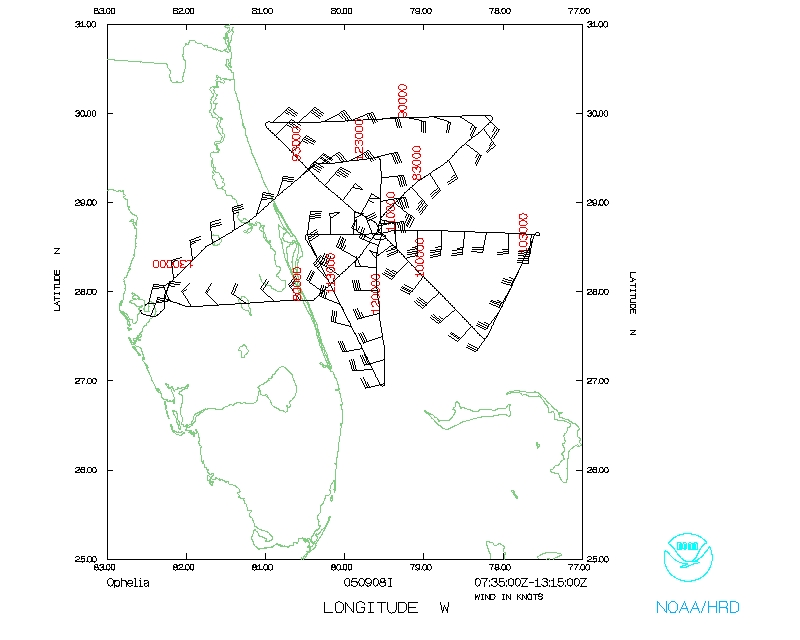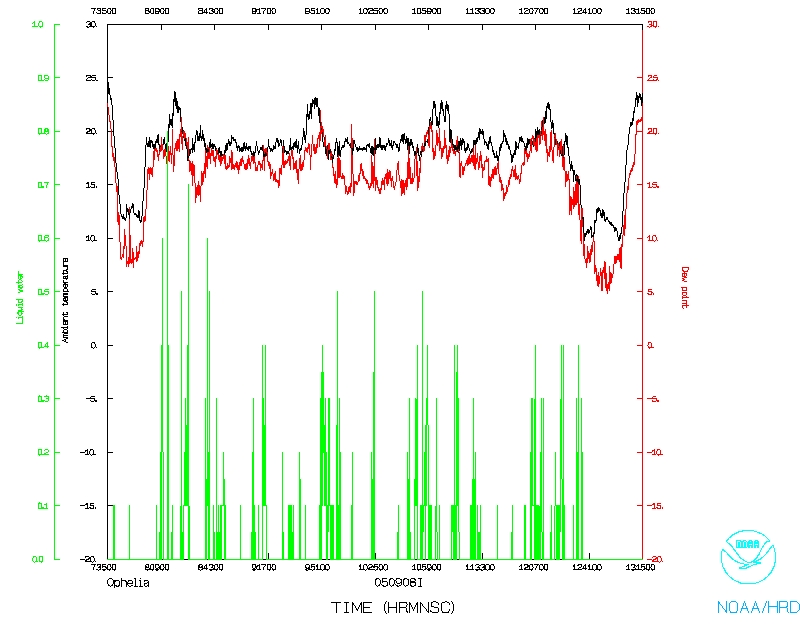Mission Data :
Flight Data | ||
 Flight track |
 Temperature and Moisture |
 Wind and Atlitude |
| Rob Rogers | LPS |
| Peter Dodge | Radar |
| Sim Aberson | Dropsonde |
| Ed Walsh (SRA) | Boundary-Layer Scientist |
| Randy Tebeest, Mike Silah, Barry Choy | Pilots |
| Joe Kippel | Flight Engineer |
| Tim Gallagher | Navigator |
| Barry Damiano, Martin Mayeaux | Flight Directors |
| Terry Lynch, Damon San Souci, Ray Tong | Engineers |
NHC-tasked fix mission into Tropical Storm Ophelia. The NOAA P3 will leave MacDill AFB,FL at 03:30 AM EDT and fly rotating figure-4 pattern into system at 5000 ft. altitude. Drop NHC sondes at turn points, center, and at flight-level RMW. Collect radar observations and sondes from frequent-monitoring experiment. Run the tail radar in F/AST mode for all legs except for the outbound west leg, where it would be run in continuous mode. The plane will recover at MacDill AFB, FL at 11:30 AM EDT.
Mission Summary :
N43RF was tasked for another overnight flight, with fix responsibilities, at 09, 12, and 15 UTC. It left MacDill AFB,FL at 03:30 AM EDT. There would be a rotating figure-4 pattern flown at 5000 ft altitude. NHC sondes would be dropped at the turn points, the center, and at the flight-level radius of maximum winds. These sondes, in addition to the radar observations, would provide data for the Frequent Monitoring experiment, which would again be piggy-backed onto this tasked mission. The tail radar would be flown in F/AST mode for all legs except the outbound west leg, where it would be run in continuous mode.
Satellite imagery from before the time of takeoff (Fig. 1) show that outflow was significantly inhibited on the southeast side of the storm. This indicates southeasterly shear, which was confirmed by a CIMSS shear analysis valid at the same time (Fig. 2). A visible image taken several hours later (Fig. 3) shows distinct banding features wrapping from the west around to the north side of the storm, with some convective elements also forming on the south side of the circulation center. The presence of growing deep convection is also supported by a radar image from Melbourne (Fig. 4), which shows a clear eye in the reflectivity field and a solid patch of deep convection on the south side of the eyewall. The banding feature seen in the visible image is also clear in the radar image, wrapping from south of the center around to the west and then north of the storm. The rain on the downwind (south) side of the band is primarily solid stratiform, while moving upwind (around the west to the north) of the band the band consists of more individual convective elements.
During the flight the storm deepened from the previous mission to a minimum pressure of 987 hPa, with maximum surface winds of 50-55 kt. This is the fourth mission in two days for this storm, making it a great frequent-monitoring case. N43RF obtained F/AST data in all quadrants, and we were able to produce Doppler analyses during the flight and transmit them to the ground. One leg was in continuous mode for vertical incidence, and the cloud physics worked well. All in all it was a very successful mission which recovered at MacDill AFB, FL at 9:45 AM EDT.
Problems :
There were no significant problems on this mission.
Robert Rogers
9/17/05
Mission Data :
Flight Data | ||
 Flight track |
 Temperature and Moisture |
 Wind and Atlitude |